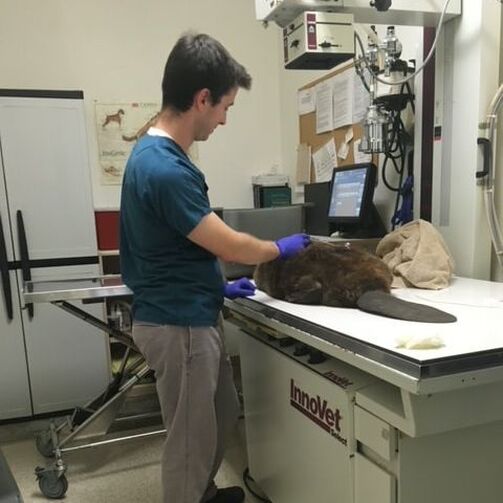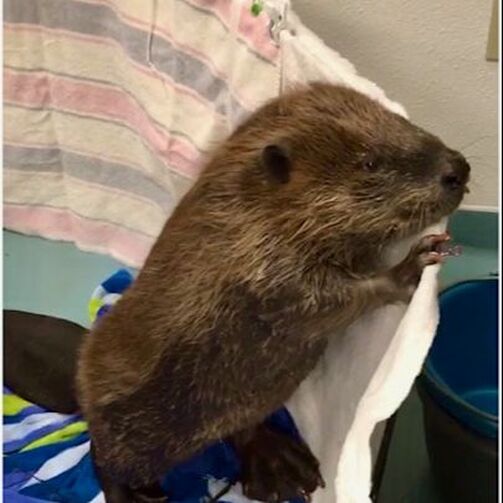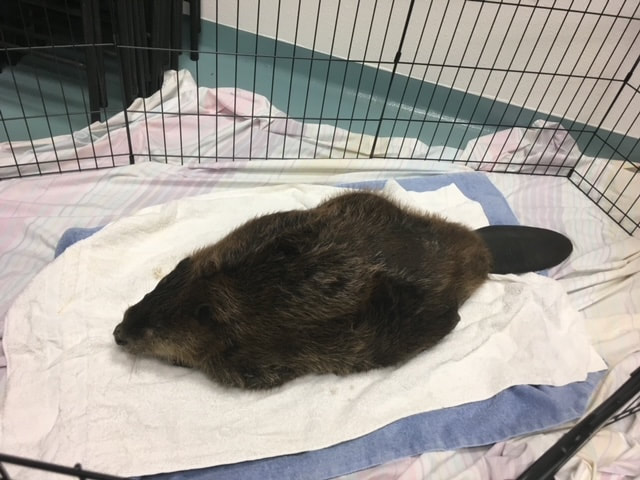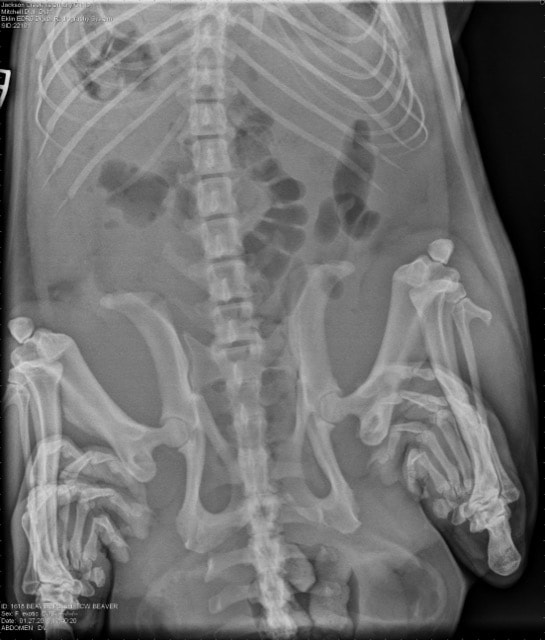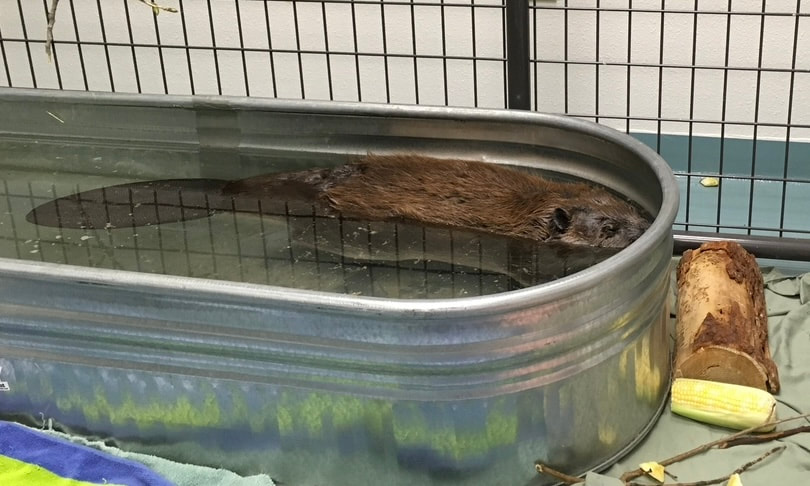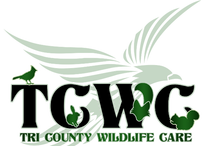The Lost Beaver
TCWC and Our Community of Angels Rally to Save Ailing Beaver
By Susan Manning
On December 26, I received a call on the Tri County Wildlife Care line from a woman A-PAL Humane Society had worked with when she rescued a horse named Spark. Spark was rescued from a show, where he had been used in a cruel game of tripping…but that is another story.
Cam told me she had a beaver in her barn! I asked her to text a photo to me and was shocked to see it was indeed a beaver. When I called her to coordinate a game plan, she asked me if I thought that she had been drinking! I did because I had never in my 22 years of working in wildlife rescue encountered a beaver in a barn.
The difficult thing about this is that there was no beaver habitat nearby, and we did not know what “normal” beaver behavior was. Once we were able to determine we needed to take the beaver, I called Tasha and Teddy to pick the beaver up.
They did not know what to expect, but as animal lovers, we were all thrilled at the prospect of working with such an amazing creature. We always wear gloves, but Tasha and Teddy only needed to do a little push and the big beaver entered the crate. Initially, we spoke with Sheryl of Lake Tahoe Wildlife Care, who explained that beavers are docile creatures that do not view humans as predators and do not usually bite. We took our beaver to Dr. Mitchell Dial, who shares our love of wildlife, to have him or her examined. He found nothing broken so we took her to see if she just needed water and a place to rest.
Our beaver did not want to eat and was not active, so we knew something was wrong. Back to Dr. Mitch she went for x-rays and fluids. The fluids gave her a lift, and we sought out a veterinarian who worked with beavers. He worked with the Martinez Beaver Organization in New York and determined that this beaver had pneumonia and needed antibiotics to heal.
Dr. Mitch had weighed her, and this big girl was a whopping 51.9 lbs. We had no idea beavers could get this big and at this weight, she would need a lot of antibiotics. Now we needed to determine how best to give them to her. We decided to give the medicine orally with applesauce. About midway through her treatment, we figured out the best way to do this. Initially we would pull her out of the crate and it would take 3 people to wrestle this big, strong, agile creature. She has clawed legs in front and webbed feet in back. She would use her front feet to push the syringe away from her mouth. We learned that crawling into her crate when she was sleeping deeply made the process much more simple. Marci worked with this beaver daily to give her medications and clean and mop up all of the water she sloshed.
Beaver have two sets of lips. They have lips at the front of their face and another set behind their teeth. This second set allows them to carry limbs into and under the water without getting a mouth full of water.
Rehabilitating this beaver took a whole team of people. While she was really sick, two people would lift her in and out of a tub of water several times a day. The worry was the worst thing we suffered through. She refused to eat and did not want to leave her crate. We feared we would lose her.
After the initial dose of antibiotics, she began to improve quickly. Our next concern was whether she could get in and out of the tub of water by herself, and she quickly showed us she could. She also showed us she could easily break out of her enclosure by standing on her back legs and pulling until it came crashing down. We had to switch out the puppy pens for a welded wire dog kennel and swap the Rubbermaid tank for a metal one. In a single night, our beaver had chewed 5 large holes in the thick Rubbermaid tank and flooded our baby bird nursery…who knew? Our beaver friends in New York and Colorado knew and had a good laugh.
We also had no idea what to feed a beaver and friends Wally and Amy came to the rescue with cottonwood branches. She also ate apples, kale, spinach and aspen cut for us by Robert. Through our songbird nursery camera we could watch our nocturnal beaver swim, eat and build. Our next job was to find a place near where she was found to release this beaver. As we searched, Pam and Mark agreed to take the beaver to an outdoor enclosure where she could acclimate to outdoors. This is no easy task because the tank must be emptied daily with a pump, and lots of construction wood and limbs hauled in too.
In a time of drought beavers build and restore wetlands, so we were surprised that no preserve or conservation lands wanted this beaver. We checked out one wonderful property that Christine offered, but the water dries up at times in the summer, so it was not appropriate.
Cam came to the rescue with a property that had beavers move out last year when heavy rains destroyed their construction. These wonderful people, Connie and John, would be happy to take the beaver. This beaver had no stored food, so this property that had lots of willow and flowing water would be perfect. What we also loved was that these kind people had fought off an attempt to divert this water, which was essential wildlife habitat, to a golf course. Release day arrived, and it would be entirely different than most. Connie and John met Pam and me with lots of helpers to lift the beaver in her crate up and out of the truck. We moved her down to the water and left.
Connie and John checked hours later to find the beaver gone. I think she waited for us to leave and was drawn by the sound of flowing water back into the wild where she belongs and where she will hopefully find a mate and live out a long life. At the age of two, beavers are kicked out of their family to travel out to find a new home and mate. We hope we gave this one what we always strive for: a great new beginning and a second chance at freedom.
Cam told me she had a beaver in her barn! I asked her to text a photo to me and was shocked to see it was indeed a beaver. When I called her to coordinate a game plan, she asked me if I thought that she had been drinking! I did because I had never in my 22 years of working in wildlife rescue encountered a beaver in a barn.
The difficult thing about this is that there was no beaver habitat nearby, and we did not know what “normal” beaver behavior was. Once we were able to determine we needed to take the beaver, I called Tasha and Teddy to pick the beaver up.
They did not know what to expect, but as animal lovers, we were all thrilled at the prospect of working with such an amazing creature. We always wear gloves, but Tasha and Teddy only needed to do a little push and the big beaver entered the crate. Initially, we spoke with Sheryl of Lake Tahoe Wildlife Care, who explained that beavers are docile creatures that do not view humans as predators and do not usually bite. We took our beaver to Dr. Mitchell Dial, who shares our love of wildlife, to have him or her examined. He found nothing broken so we took her to see if she just needed water and a place to rest.
Our beaver did not want to eat and was not active, so we knew something was wrong. Back to Dr. Mitch she went for x-rays and fluids. The fluids gave her a lift, and we sought out a veterinarian who worked with beavers. He worked with the Martinez Beaver Organization in New York and determined that this beaver had pneumonia and needed antibiotics to heal.
Dr. Mitch had weighed her, and this big girl was a whopping 51.9 lbs. We had no idea beavers could get this big and at this weight, she would need a lot of antibiotics. Now we needed to determine how best to give them to her. We decided to give the medicine orally with applesauce. About midway through her treatment, we figured out the best way to do this. Initially we would pull her out of the crate and it would take 3 people to wrestle this big, strong, agile creature. She has clawed legs in front and webbed feet in back. She would use her front feet to push the syringe away from her mouth. We learned that crawling into her crate when she was sleeping deeply made the process much more simple. Marci worked with this beaver daily to give her medications and clean and mop up all of the water she sloshed.
Beaver have two sets of lips. They have lips at the front of their face and another set behind their teeth. This second set allows them to carry limbs into and under the water without getting a mouth full of water.
Rehabilitating this beaver took a whole team of people. While she was really sick, two people would lift her in and out of a tub of water several times a day. The worry was the worst thing we suffered through. She refused to eat and did not want to leave her crate. We feared we would lose her.
After the initial dose of antibiotics, she began to improve quickly. Our next concern was whether she could get in and out of the tub of water by herself, and she quickly showed us she could. She also showed us she could easily break out of her enclosure by standing on her back legs and pulling until it came crashing down. We had to switch out the puppy pens for a welded wire dog kennel and swap the Rubbermaid tank for a metal one. In a single night, our beaver had chewed 5 large holes in the thick Rubbermaid tank and flooded our baby bird nursery…who knew? Our beaver friends in New York and Colorado knew and had a good laugh.
We also had no idea what to feed a beaver and friends Wally and Amy came to the rescue with cottonwood branches. She also ate apples, kale, spinach and aspen cut for us by Robert. Through our songbird nursery camera we could watch our nocturnal beaver swim, eat and build. Our next job was to find a place near where she was found to release this beaver. As we searched, Pam and Mark agreed to take the beaver to an outdoor enclosure where she could acclimate to outdoors. This is no easy task because the tank must be emptied daily with a pump, and lots of construction wood and limbs hauled in too.
In a time of drought beavers build and restore wetlands, so we were surprised that no preserve or conservation lands wanted this beaver. We checked out one wonderful property that Christine offered, but the water dries up at times in the summer, so it was not appropriate.
Cam came to the rescue with a property that had beavers move out last year when heavy rains destroyed their construction. These wonderful people, Connie and John, would be happy to take the beaver. This beaver had no stored food, so this property that had lots of willow and flowing water would be perfect. What we also loved was that these kind people had fought off an attempt to divert this water, which was essential wildlife habitat, to a golf course. Release day arrived, and it would be entirely different than most. Connie and John met Pam and me with lots of helpers to lift the beaver in her crate up and out of the truck. We moved her down to the water and left.
Connie and John checked hours later to find the beaver gone. I think she waited for us to leave and was drawn by the sound of flowing water back into the wild where she belongs and where she will hopefully find a mate and live out a long life. At the age of two, beavers are kicked out of their family to travel out to find a new home and mate. We hope we gave this one what we always strive for: a great new beginning and a second chance at freedom.
Tri County Wildlife Care, a local nonprofit started in 1994, is dedicated to the rescue and rehabilitation of our native wildlife and helping our community live in balance with wildlife. We envision a world where wildlife and people thrive together. For more information call (209) 283-3245, or visit us at pawspartners.org.
